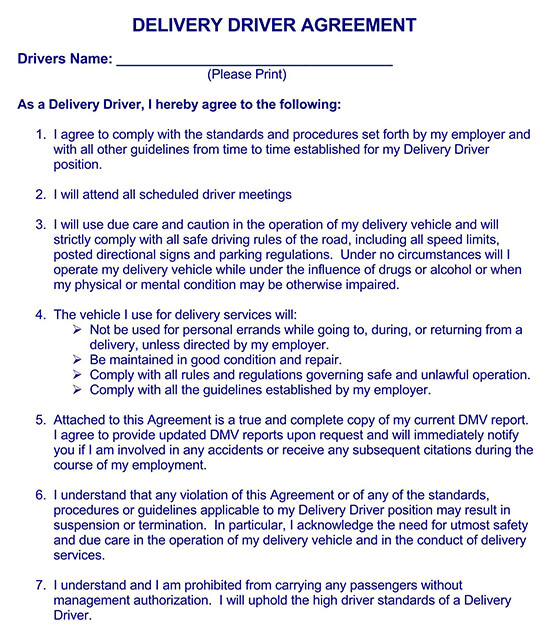How To Get A Delivery Contract

Obtaining a delivery contract can be a lucrative opportunity for businesses, particularly in the logistics and transportation industry. In today's competitive market, securing a reliable and long-term delivery contract is a challenging yet rewarding endeavor. This comprehensive guide will explore the essential steps, strategies, and considerations to help businesses navigate the process of acquiring delivery contracts successfully.
Understanding Delivery Contracts

A delivery contract, also known as a transportation or logistics agreement, is a formal arrangement between a client (usually a manufacturer, retailer, or distributor) and a service provider (a logistics company or a self-owned delivery business). These contracts outline the terms and conditions for the transportation and delivery of goods from the client’s premises to their desired destinations.
Delivery contracts can vary widely in scope and complexity. Some contracts may involve simple local deliveries, while others encompass intricate supply chain management for multinational corporations. The duration of these contracts can range from short-term projects to long-term partnerships spanning several years.
The key components of a delivery contract typically include:
- Scope of Work: Details the specific services to be provided, such as type of transportation (road, rail, air, or sea), delivery routes, and special requirements.
- Pricing and Payment Terms: Specifies the cost structure, including per-delivery charges, volume discounts, and any additional fees.
- Performance Metrics: Outlines key performance indicators (KPIs) to measure the service provider's efficiency and reliability.
- Service Level Agreements (SLAs): Defines the expected delivery timelines, quality standards, and any penalties or bonuses associated with meeting or exceeding SLAs.
- Insurance and Liability: Covers the responsibilities and financial obligations in case of damage, loss, or accidents during transit.
- Termination Clauses: Specifies the conditions under which either party can terminate the contract and the associated procedures.
Identifying Potential Clients

Securing a delivery contract begins with identifying potential clients who have a need for your specific transportation services. This involves market research and understanding the logistics landscape in your target region.
Industry Analysis
Start by analyzing the industries and sectors that rely heavily on transportation services. For instance, e-commerce, retail, manufacturing, and healthcare are sectors that often require efficient delivery solutions.
Conduct a SWOT (Strengths, Weaknesses, Opportunities, Threats) analysis to evaluate your business's position in the market. Identify your unique strengths and capabilities that can be leveraged to cater to specific industries. For example, do you have specialized vehicles for temperature-controlled goods or expertise in last-mile delivery solutions for urban areas?
Targeted Marketing
Develop targeted marketing strategies to reach out to potential clients. This can include online advertising, attending industry conferences and trade shows, and building relationships with industry influencers and associations.
Create personalized marketing materials that highlight how your delivery services can address specific pain points or challenges faced by the target industry. Demonstrate your understanding of their unique needs and propose tailored solutions.
| Industry | Pain Points | Proposed Solutions |
|---|---|---|
| E-commerce | Last-mile delivery challenges, meeting customer expectations for fast delivery | Implementing a dynamic routing system, offering real-time tracking and updates |
| Healthcare | Sensitive and time-critical deliveries, ensuring product integrity | Providing specialized vehicles with temperature control and real-time monitoring systems |
| Manufacturing | Transporting large or bulky goods, ensuring timely deliveries to meet production schedules | Offering customized vehicles and equipment, providing regular delivery updates |

Building a Competitive Portfolio
To stand out in a competitive market, it’s crucial to build a robust portfolio that showcases your capabilities and reliability as a delivery service provider.
Diversify Your Services
Expand your service offerings to cater to a wider range of clients. This could include providing specialized services like hazardous materials transportation, temperature-controlled deliveries, or freight forwarding for international clients.
Invest in the necessary equipment, vehicles, and infrastructure to support these diversified services. Ensure your fleet is well-maintained and equipped with the latest technologies for efficient tracking and management.
Develop a Strong Brand Identity
Build a recognizable brand that conveys trust, reliability, and expertise in the logistics industry. Develop a professional logo, consistent branding across all marketing materials, and a user-friendly website that highlights your services and past projects.
Establish a strong online presence through search engine optimization (SEO) and social media marketing. Share informative content, industry insights, and case studies that demonstrate your expertise and value proposition.
Establish Partnerships
Form strategic partnerships with complementary businesses to expand your reach and capabilities. For instance, partnering with a warehousing and distribution company can enhance your ability to offer end-to-end logistics solutions.
Collaborate with technology providers to integrate innovative solutions into your operations. This could include using advanced tracking systems, route optimization software, or even implementing drones for last-mile deliveries in certain scenarios.
Crafting Compelling Proposals
When submitting proposals to potential clients, it’s essential to showcase your understanding of their needs and propose customized solutions that add value to their operations.
Client-Centric Approach
Take the time to thoroughly understand the client’s business, their pain points, and their specific delivery requirements. Engage in open communication and ask clarifying questions to ensure you have a comprehensive understanding of their expectations.
Propose solutions that go beyond basic transportation services. Offer insights and recommendations for process improvements, cost-saving measures, or innovative strategies that can enhance their supply chain efficiency.
Tailored Pricing Strategies
Develop pricing models that are competitive yet profitable. Consider the client’s budget constraints and propose volume-based pricing, discounts for long-term contracts, or performance-based incentives.
Ensure your pricing structure is transparent and easy to understand. Break down the cost components and highlight the value they receive for each service or feature included in the contract.
Incorporating Technology
Highlight the use of technology in your proposal to demonstrate your commitment to efficiency and innovation. Describe how technology, such as real-time tracking systems or automated dispatch software, can benefit the client’s operations and improve overall delivery performance.
Provide case studies or testimonials from previous clients who have benefited from your technology-driven approach. This can help build trust and showcase the tangible results you can deliver.
Negotiation and Contract Finalization

Once your proposal is accepted, the next step is to negotiate the contract terms and finalize the agreement with the client.
Setting Clear Expectations
Clearly communicate your expectations and the services you will provide. Ensure that both parties have a mutual understanding of the scope of work, timelines, and any potential risks or challenges.
Address any concerns or objections raised by the client during the negotiation process. Be prepared to provide additional information, case studies, or references to build confidence in your ability to deliver on the contract terms.
Flexible and Adaptable Approach
Maintain a flexible and adaptable mindset during negotiations. Be open to discussing alternatives or compromises to reach a mutually beneficial agreement. Remember that building a long-term relationship with the client is the ultimate goal.
Consider offering trial periods or pilot projects to demonstrate your capabilities and build trust. This can be especially effective when dealing with larger corporations or clients who may have complex delivery requirements.
Legal and Compliance Considerations
Ensure that the contract is legally sound and compliant with industry regulations. Consult with legal professionals to review the contract terms and address any potential risks or liabilities.
Pay close attention to the termination clauses and ensure they are fair and reasonable for both parties. Define the circumstances under which the contract can be terminated and the associated procedures and financial implications.
Delivering Exceptional Service
Once the contract is signed, the focus shifts to delivering exceptional service and meeting the client’s expectations.
Efficient Operations
Implement efficient operational processes to ensure timely and accurate deliveries. Train your staff on the specific requirements of the contract and maintain open lines of communication to address any issues promptly.
Utilize technology to optimize routes, manage inventory, and track deliveries in real time. Regularly review performance metrics and make data-driven decisions to continuously improve your operations.
Customer Service Excellence
Go above and beyond in providing exceptional customer service. Establish a dedicated customer support team to handle client inquiries, concerns, and feedback promptly and professionally.
Implement a feedback loop system to gather client feedback regularly. Act on their suggestions and implement process improvements to enhance their overall experience with your delivery services.
Continuous Improvement
Embrace a culture of continuous improvement within your organization. Encourage innovation and creativity in finding new ways to enhance your delivery services.
Stay updated with industry trends and technological advancements. Invest in training and development programs for your staff to ensure they have the skills and knowledge to adapt to changing market dynamics.
Building Long-Term Partnerships
The ultimate goal of securing a delivery contract is to build a long-term partnership with the client. This requires a commitment to excellence, reliability, and adaptability over the duration of the contract.
Regular Performance Reviews
Schedule regular performance reviews with the client to discuss their satisfaction with your services. Use these meetings to gather feedback, address any concerns, and celebrate your achievements together.
Demonstrate your commitment to continuous improvement by implementing changes based on the client's feedback. Show them that their input is valued and contributes to the evolution of your delivery processes.
Value-Added Services
Look for opportunities to provide additional value to the client beyond the scope of the initial contract. Offer complimentary services or propose innovative solutions that can further enhance their supply chain efficiency.
For example, you could suggest implementing a return logistics program to streamline the process of managing returns and exchanges, thereby reducing costs and improving overall customer satisfaction.
Relationship Building
Foster strong relationships with key stakeholders within the client’s organization. Attend industry events and conferences to network and build personal connections.
Offer your expertise and insights as a thought leader in the logistics industry. Share valuable information, best practices, and industry trends with your client to position yourself as a trusted advisor.
Referrals and Testimonials
Encourage satisfied clients to provide referrals or testimonials that can be used in your marketing materials. Positive word-of-mouth recommendations can be powerful tools to attract new business and build your reputation in the industry.
Consider offering referral bonuses or incentives to your clients for successful referrals. This can create a win-win situation where your clients benefit financially while you expand your business network.
Conclusion: Navigating the Delivery Contract Journey
Securing a delivery contract is a complex process that requires a strategic approach, a deep understanding of the market, and a commitment to delivering exceptional service. By following the steps outlined in this guide, businesses can increase their chances of success in acquiring lucrative delivery contracts.
Remember that building long-term partnerships is key to sustaining your business in the competitive logistics industry. Continuously strive to exceed expectations, adapt to changing market dynamics, and provide value-added services to your clients. With a client-centric mindset and a focus on continuous improvement, you can establish yourself as a trusted and reliable delivery partner in the industry.
What are some common challenges faced when pursuing delivery contracts?
+Pursuing delivery contracts can present several challenges, including intense competition from established logistics companies, fluctuating market conditions, and the need to continuously invest in technology and infrastructure to stay competitive. Additionally, managing client expectations and ensuring timely deliveries can be demanding.
How can I differentiate my delivery services from competitors?
+To differentiate your services, focus on specialized offerings, such as temperature-controlled deliveries or hazardous materials transportation. Showcase your technological advancements, like real-time tracking systems or automated dispatch software. Also, emphasize your commitment to customer service excellence and continuous improvement.
What are some effective strategies for negotiating delivery contract terms?
+When negotiating contract terms, be prepared to discuss alternatives and compromises. Emphasize your willingness to adapt and provide value-added services. Highlight the benefits of long-term partnerships and the potential for cost savings through volume-based pricing or performance incentives. Always maintain a professional and respectful tone during negotiations.



